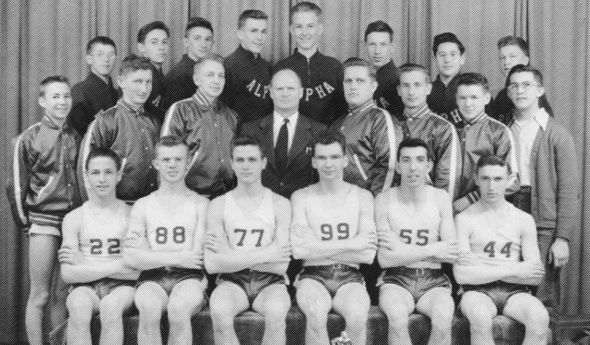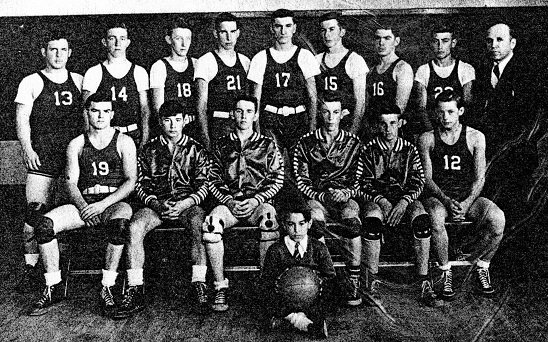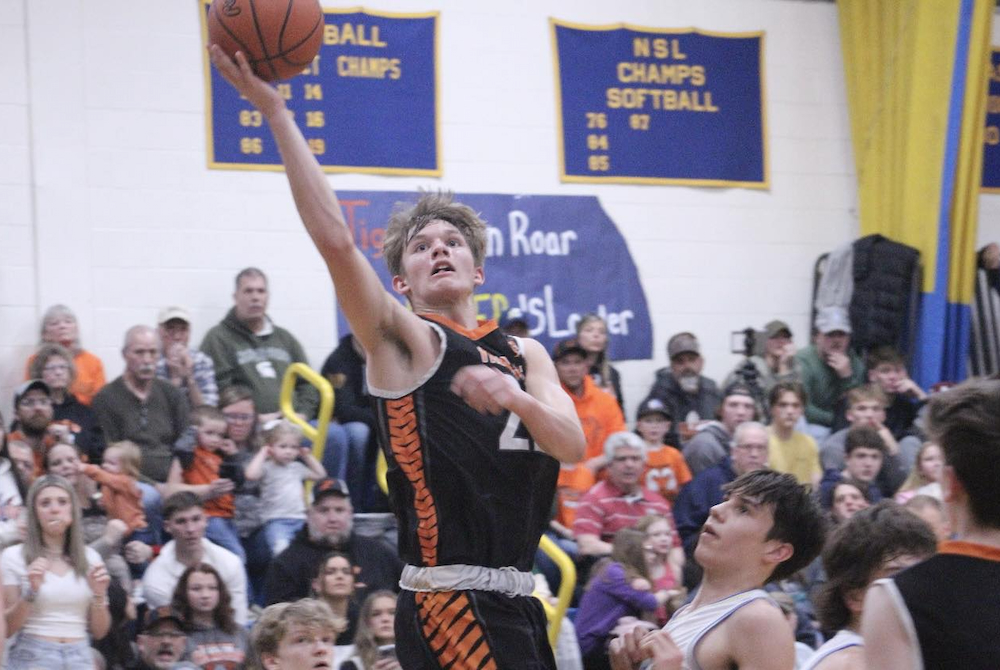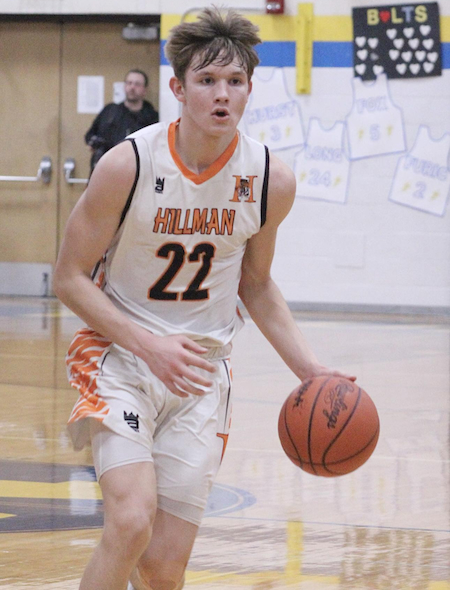
Before the Bridge: Class E & the UP
July 31, 2017
By Ron Pesch
MHSAA historian
This is the final part in a series on MHSAA tournament classification, past and present, that has been published over the last two weeks and originally ran in this spring's edition of MHSAA benchmarks.
The stories are worthy of the silver screen.
Long lost legends of lore, forgotten by most in the Lower Peninsula of the state of Michigan.
Absurd anecdotes of basketball played behind glass, and out-of-bounds lines painted on walls.
Tales of overlooked places like Trenary and Champion and Doelle and Watersmeet.
This is the story of MHSAA Class E basketball.
From 1932 to 1947, Michigan's Upper Peninsula did not compete in the state-sponsored basketball tournament. Instead, the U.P. held a separate basketball tournament, crowning champions in Classes B, C and D. In 1941, the state added a fifth classification – Class E, comprised of schools with a student body numbering 75 or fewer. A fourth bracket was added to the U.P. tourney.
Following the 1948 season, the Upper Peninsula returned to the state tournament. Winners of the traditional U.P. tourney were pronounced regional champions, and advanced to the state quarterfinals in Classes B, C and D. However, since there were no Class E schools with basketball teams in the Lower Peninsula, the winner of the U.P. tournament crown was proclaimed Class E state champion. This arrangement continued through the spring of the 1960 season.
Since they were the state's smallest high schools, the gymnasiums came in all shapes and sizes. Some sported a center circle that intersected with the top of the key. Basketball courts that doubled as a stage required netting to keep the kids and the ball on the court and away from the audience seated below.
Fred Boddy, a former coach at Champion, recalled his first visit to Doelle. Located in copper country near Houghton, the hosts were the proud owners of “the smallest” gym in U.P.
“I couldn't believe my eyes. ... Here on the second floor were windows and bleachers all around filled with fans. The gym, of course, was located on the first floor, but to get into the gym one had to go around to the back of the school to enter through the boiler room to the locker rooms, which opened onto the gym floor much like a dugout on a baseball field. The players sat on a bench under the wall and could look out and see the game in this manner. The free throw lines intersected and there were no out of bounds lines... the wall itself was ‘out of bounds.’ On the floor during the game were 10 players and two referees. There were no sounds as all the fans were up on the second floor, glassed in.
The cheerleaders tried valiantly to fire up the fans up on the second floor, but the teams couldn't hear in the quiet below. The score clock and statistician personnel were placed in a corner box high over the floor in one corner of the gym. They attained this lofty perch by a ladder that was removed from the trap door after all three were in position and the game could thus commence. The timer then tied a rope around his ankle. To send a sub into the game the coach would send the player along the wall heading for this rope. He would pull the rope causing the timer to look down through the trap door and at next opportunity would ring the buzzer and admit this substitute”
Regardless of the challenges presented by these cracker-box gyms, the fans loved their basketball. “The enthusiasm was just the same, if not bigger, than schools twice and 10 times their size,” noted longtime U.P. historian, Jay Soderberg.
Coach Joseph Miheve's 1941 Palmer squad captured the state's first Class E title with a 39-28 win over Hulbert at Ironwood. A graduate of Wakefield High School, Miheve had never played high school basketball, serving as the team's manager.
The 1942 tournament, scheduled for March 19-21, was postponed one week because the city of Marquette was more or less taken over “by nearly 1,000 selective service registrants from every county in the Upper Peninsula” who had another and more serious battle in mind – World War II.
Palmer, this time coached by Elvin Niemi, repeated in Class E with a 37-31 victory over Bergland. It was Palmer's 32nd consecutive victory.
No tournament was held in 1943 due to the involvement of the United States in the war. In the 1944 championship game, Cedarville jumped out to a 19-14 first quarter lead but was held to 24 points in the remaining periods and fell to Amasa, 51-43 at Ishpeming.
Trenary made its lone Class E finals appearance in 1945, losing to Bergland 49-39 at Ishpeming, while the Alpha Mastodons won their first U.P. title since 1934 with a 48-28 win over Champion in 1946. It was the second of five Class E titles for Alpha coach Gerhardt “Gary” Gollakner, one of the finest coaches to come out of the U.P. Gollakner had coached at Amasa two years earlier, and his Mastodons would earn three additional titles during the 19-year run of the Class E championships.
Bergland became the tourney's second two-time winner in 1947, with a 40-37 win over the Perkins Yellowjackets. Perkins made four trips to the Class E finals over the years, including an appearance in the final year of the tournament, but came away empty-handed each time.
The Nahma Arrows made their first appearance in the championship in 1951, losing to Michigamme. Led by coach Harold “Babe” Anderson, a cage star at Northern Michigan College during the early 1940s, the Arrows returned to the finals in 1952. Nahma finished the year with a 21-0 mark and a 64-44 win over Marenisco for the crown.
 The two teams met again in a finals rematch the following year. The scored was tied six times, while the lead changed hands seven times in this barnburner. With 15 seconds to play, Nahma led 64-60. Marenisco's Robert Prosser hit a jump shot, then teammate Bill Blodgett stole a pass and scored to knot the game at 64. With two seconds remaining, Nahma's Bernard Newhouse was fouled. Newhouse hit the first free throw, but missed on the second. Teammate Wendell Roddy tipped in the rebound, and the Arrows had their second title.
The two teams met again in a finals rematch the following year. The scored was tied six times, while the lead changed hands seven times in this barnburner. With 15 seconds to play, Nahma led 64-60. Marenisco's Robert Prosser hit a jump shot, then teammate Bill Blodgett stole a pass and scored to knot the game at 64. With two seconds remaining, Nahma's Bernard Newhouse was fouled. Newhouse hit the first free throw, but missed on the second. Teammate Wendell Roddy tipped in the rebound, and the Arrows had their second title.
Alpha returned to the championship circle in 1954 with a 52-48 win over Perkins.
The 1955 title game matched a pair of the finest teams in Class E history. Trout Creek, making its first championship appearance, downed Alpha 84-83 in another Class E thriller. Don Mackey led the winners with 39 points. Tony Hoholek paced Alpha with 31, while junior John Kocinski added 21-points for the Mastodons.
Kocinski, a four-year starter at Alpha, scored 1,782 points during his career, then an all-time U.P. record. He once scored 51 points against Amasa, and could have scored more according to teammate Walter “Slip” Ball. “He refused to shoot in the fourth quarter, and passed up one shot after another,” Ball said.
Without question, Trout Creek was one of the powerhouse squads during the final years of the tourney. The Anglers, coached by Bruce “Pinky” Warren, a former captain of Purdue's football team, made four trips to the finals during the last six years of the Class E tourney. The defending champions downed Alpha in the semifinals of the 1956 tournament, then knocked off Hermansville 86-68 in the finals to repeat. It was a year of celebration for fans of U.P. basketball, as four of the state's five champions – Stephenson (B), Crystal Falls (C), Chassell (D) and Trout Creek (E) – came from Michigan's northern peninsula.
Hermansville returned to the finals in the spring of 1957 and earned its second Class E title with a 77-51 win over Michigamme at Escanaba. Trout Creek downed Perkins 61-41 for their third crown in 1958.
The 1959 championship, hosted at Northern Michigan College's fieldhouse, was a showdown of the U.P.’s only undefeated squads, Trout Creek and Nahma. Trout Creek was riding a 24-game winning streak that dated back to the 1958 season. A scoring machine, Warren's Anglers averaged 81.7 points per contest. Nahma, 19-0 on the season, boasted the U.P.'s strongest defense. Still coached by “Babe” Anderson, the Arrows had allowed an average of 38.2 points per game. Led by senior Warren Groleau, Nahma had been last defeated by Trout Creek in the semifinals of the 1958 tourney.
Leading 25-15 at the intermission, Nahma matched Trout Creek point for point in the second half for a 55-45 victory.
Hermansville, behind Richard Polazzo's 29 points and Irwin Scholtz's 27, downed surprise finalist Perkins 72-50 in the 1960 finale, to end this chapter in MHSAA history.
Today, most of the former Class E high schools are long gone. Many have closed their doors and consolidated with other area schools. Amasa and Alpha merged with Crystal Falls to form Forest Park. Palmer is now part of the Negaunee school system. Bergland and Trout Creek joined forces with Class D Ewen to form Ewen-Trout Creek. Hermansville combined with Powers to form North Central, to name but a few. A few remain: Dollar Bay, Marenisco (now Wakefield-Marenisco) and Watersmeet, and their enrollments are much the same as in the glory days of the state's fifth classification.
Author’s note: Special thanks to Jay Soderberg and Roger Finlan, who assisted in gathering statistics and quotes used in this article. Thanks also to Dick Kishpaugh, Bob Whitens, Walter “Slip” Ball, Dennis Grall, Fred Boddy, Bruce Warren, Gene Maki, Harold “Babe” Anderson and the various personnel at U.P. high schools for their contributions to this story.
PHOTOS: (Top) The Alpha boys basketball team won the 1950 Class E title by nearly doubling up Michigamme, 52-28. (Middle) Hermansville claimed the 1948 title with a 58-38 win over Rockland.

Taratuta Tops Hillman's Leaderboard, Striving to Take Tigers on Title Pursuit
By
Tom Spencer
Special for MHSAA.com
January 5, 2024
A lot of has been written about Hillman senior point guard Trenton Taratuta.
 And Taratuta has re-written pretty much every basketball record in the Hillman history book as well.
And Taratuta has re-written pretty much every basketball record in the Hillman history book as well.
He would trade everything, though, for a shot at the Breslin Center and playing in the Division 4 Boys Basketball Final.
Taratuta entered this season with 1,612 career points, leaving him only 68 away from the school scoring record.
“First things first, I am just a competitor – I want to win,” Taratuta said of his Breslin goal. “The personal accolades come along with it, but winning is everything.”
Eric Muszynski, the Tigers’ boys basketball coach for the past 19 years, guarantees his four-year starter and most decorated player in Hillman history would give up every one of his records for the chance to win at Breslin.
“The beauty of Trenton is I know he would sacrifice these individual accolades to get down to the Breslin Center,” Muszynski said. “It’s a real treat to coach him.
“You tell kids, ‘If you put the time in and hard work in, results happen,’” Muszynski continued. “It has been awesome to be able to use him as an example to a lot of our youth basketball players and some of our current players that have seen the work he’s put in and the results he is getting.”
Taratuta is the only starter returning from last year’s team that lost a 59-57 heart-breaker to Frankfort in the Quarterfinals. He did become the highest scorer in Hillman’s history during a 57-56 overtime win over Oscoda on Dec. 7. He set the mark within his team’s first bucket of the game and then won it with a buzzer-beating 3-pointer that allowed him to again tie the school record for the most points in a single game with 41.
The 6-foot-4 guard, who has scored 41 three times during his career, wants to ride the community support the entire 200-plus miles in March to Breslin. Last year’s run remains bigger to Taratuta than all his current individual records.
“My favorite memory so far is our postseason run last year,” he said. “The support we got from our community was overwhelming.
“It was fun to see everyone come support us and the crowds we got,” he continued. “It was a great atmosphere for all the playoff games.”
Hillman is off to a 6-2 start after winning its North Star League Little Dipper opener Thursday night over Posen, 72-51, as Taratuta led with 30 points. The Tigers’ only losses this winter have been to Division 2 schools, Gaylord and Ogemaw Heights.
 Taratuta now has 1,858 points for his career and set his sights on reaching 2,000. His coach thinks it is highly likely he’ll be able to do that and then climb toward the total accrued by the leading scorer in Michigan high school history, Jay Smith, from 1975-76 through 1978-79.
Taratuta now has 1,858 points for his career and set his sights on reaching 2,000. His coach thinks it is highly likely he’ll be able to do that and then climb toward the total accrued by the leading scorer in Michigan high school history, Jay Smith, from 1975-76 through 1978-79.
That said, Taratuta, who is averaging more than 30 points per game this season, is unlikely to challenge Smith’s 2,841 career points – but both Taratuta and his coach also look to the record with pride as Mio is less than 40 miles down the road from Hillman.
Only 45 others in MHSAA boys hoops history have reached 2,000 career points.
“The 2,000-point mark would be pretty special,” Taratuta acknowledged. “It would be pretty cool.”
Hillman, which will host the District tournament this year, expects to ride Taratuta’s success a long way this postseason. Atlanta, Fairview, Hale, Mio and Posen are the Tigers’ potential District opponents.
“There is a lot of season left and a lot of work to be done,” Taratuta said. “I am looking forward to the rest of the season.
“I’m focused on the team’s overall success, not thinking about the points,” he continued. “Coming into this year, there were a lot of doubters and the guys have stepped up well.”
Senior center Blake Kennard is averaging 11.1 points per game and chipping in more than seven rebounds and almost three blocks. Junior 3-point specialist Brenden Rouleau is also averaging double-digit scoring.
Taratuta – who is from a family of high-scoring Hillman graduates – had his sights set on the career points record for quite a while. He was at the game in 2015 when Mason VanPamel broke Paul Bennett’s longstanding scoring record set in 1986.
“He comes from a pretty good pedigree of athletes,” Muszynski said. “His uncles Greg, Jeff and Tim Jones are all thousand-point scorers in our school, and they’re in our Hall of Fame.
Taratuta also just may be a one-of-a-kind, talented, hard-working team player, his veteran coach noted.
“Not only can he score it, he is top-five in our school’s history in every major statistical category going into his senior year,” Muszynski continued. “He is one of those guys where you’re not sure if you’re going to see somebody of that caliber again in your career.
“I was pretty fortunate to have a couple of other guys that were pretty solid, and it’s built the tradition of our basketball program to where Trenton is at.”
 Tom Spencer is a longtime MHSAA-registered basketball and soccer official, and former softball and baseball official, and he also has coached in the northern Lower Peninsula area. He previously has written for the Saginaw News, Bay County Sports Page and Midland Daily News. He can be reached at [email protected] with story ideas for Manistee, Wexford, Missaukee, Roscommon, Ogemaw, Iosco, Alcona, Oscoda, Crawford, Kalkaska, Grand Traverse, Benzie, Leelanau, Antrim, Otsego, Montmorency, Alpena, Presque Isle, Cheboygan, Charlevoix and Emmet counties.
Tom Spencer is a longtime MHSAA-registered basketball and soccer official, and former softball and baseball official, and he also has coached in the northern Lower Peninsula area. He previously has written for the Saginaw News, Bay County Sports Page and Midland Daily News. He can be reached at [email protected] with story ideas for Manistee, Wexford, Missaukee, Roscommon, Ogemaw, Iosco, Alcona, Oscoda, Crawford, Kalkaska, Grand Traverse, Benzie, Leelanau, Antrim, Otsego, Montmorency, Alpena, Presque Isle, Cheboygan, Charlevoix and Emmet counties.
PHOTOS (Top) Hillman’s Trenton Taratuta (22) gets to the basket as the crowd anticipates two points. (Middle) Taratuta considers his next move during a game against Mio. (Photos courtesy of Jonny Zawacki.)

